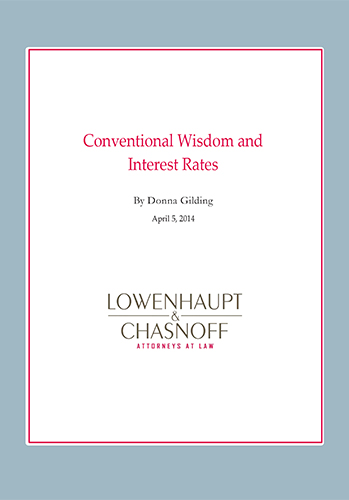Conventional Wisdom and Interest Rates
By Donna Gilding
Conventional wisdom in the investing world asserts interest rates will rise, but probably not for the next two or three years. The Bank of England and the Federal Reserve seem to be shuffling toward an exit from easy monetary policy. In addition, the European Central Bank seems to be considering an easing. On March 25, Jens Weidmann, president of the Bundesbank, suggested that the ECB might have to be “a little more forceful to keep the Euro zone economy out of deflation.” It is likely that the ECB will continue to be dictated to by its weakest members, which have been known to produce resentment and tension.
Why Would We Expect the Low-Rate Environment to Continue?
In February, Mark Carney, Governor of the Bank of England, promised that rates would rise gradually, but would level off below the pre-crises norm. Fed Chair Janet Yellen offered similar guidance in mid-March. Markets are projecting that short-term rates for both the UK and the US economies will still be about 2% in early 2017, a level the Euro zone will not reach until 2020.
As normalization recedes, central bankers are sensitive to the costs of low rates. In the US, there is a fear that low rates encourage investors to take excessive risks as they reach for yield. Even more worrying to the Fed, its main policy rate was just 2% when Lehman Brothers collapsed in 2008, compared with 5% at the start of the 2001 recession and 8% in 1990 when the downturn began.
Why are Rates Low?
Economies simply cannot withstand more expensive credit. Central banks are fighting against two sources of downward pressure on their main policy rates. One is the absolute lowest level of inflation-adjusted interest rates needed to keep economies running at full tilt. This “natural” rate has been dragged down by structural trends which include:
- A global savings glut is partly to blame.
- The OPEC countries and China buy huge quantities of “rich-world” debt, depressing borrowing costs in the process.
- Rising inequality adds to the pool of underused savings because the rich save more!
- Rapidly falling asset prices have forced households to repay debt more rapidly. As they struggled to deleverage, their interest in new borrowing and spending fell.
A second reason that rates are so low is low inflation. Since the double-digit rates of the 1970s, most central banks have set target rates around 2%. While keeping rates low is clearly an achievement, it is not without its costs. Interest rates also fell against inflation but investors were not worried because prices of their assets were increasing. As we bumped against near-zero rates, central banks began quantitative easing to combat slow growth.
It is worth noting that global inflation is fairly low with the exception of India, Brazil and a few others. As pointed out above, US inflation is running below the central bank expectations as is that of Japan. And, Japan has its own set of issues.
Japan
Japan’s “three arrows” are still being put in place. The first arrow to be implemented was the large-scale asset purchases by the Bank of Japan (BOJ), which has been successful. The second arrow is the investment in public works and infrastructure which is 50+ years old! There is concern that the spending policies could be ill-conceived like the infrastructure projects in past government’s policies. The third arrow, meant to bring structural reforms and sustainable growth to the economy, has left investors disappointed. Japanese stocks, which had risen 22%, fell back into a bear market. As late as October 2013, Shinzo Abe defended his plan and stated that he was on track to pursue his third arrow – a growth strategy to complement the first two arrows of monetary expansion and fiscal flexibility in more depth. The challenge for Japan will be to keep inflation from getting out of control while keeping the yen from depreciating too quickly.
The $64,000 Question: What Happens Now?
The Fed is not without options. Some of the pressure could be eased by higher inflation. Because inflation reduces the burden of repaying a given loan, the central banks could cut effective borrowing costs despite zero interest rates. Higher inflation would also speed up interest-rate normalization. The Fed economists published a paper last November arguing that lifting the inflation target to 3% would also lower unemployment. The Fed’s policy-making committee did not seem to be convinced. The official target of 2% was only established two years ago. Officials may be concerned that their credibility could end up being undermined by changing rates after such a short period of time. One has to wonder why the Fed is so nonchalant. Since establishing the 2% target in 2012, the Fed has undershot nearly 90% of the time. American inflation is about 1.2%. Low inflation is becoming more entrenched in the Euro zone (0.7%) and is falling in Britain, where year-over-year as of February it was 1.7%, albeit a very short timeframe.
However unlikely it may be, the central banks do have the option of promising not to tighten until inflation is back on target. The result, unfortunately, would be to make fighting the next recession much more difficult.
Changing the direction of the Fed policy from easing to tightening is also likely cause profit margins, which at an all-time high, to revert to the mean of 6% versus today’s 11%. Note that in every previous instance in which profit margins have reached extreme levels – high and low – they have subsequently reverted to (or beyond) the mean.
We can tell ourselves that profit margins have reached a plateau and will never revert to the 6% mean again. This is a bit like telling ourselves the story called, “It’s different this time” to which we can all relate on a number of levels. “It’s different this time” has also been described as the “four most expensive words in the English language.”

